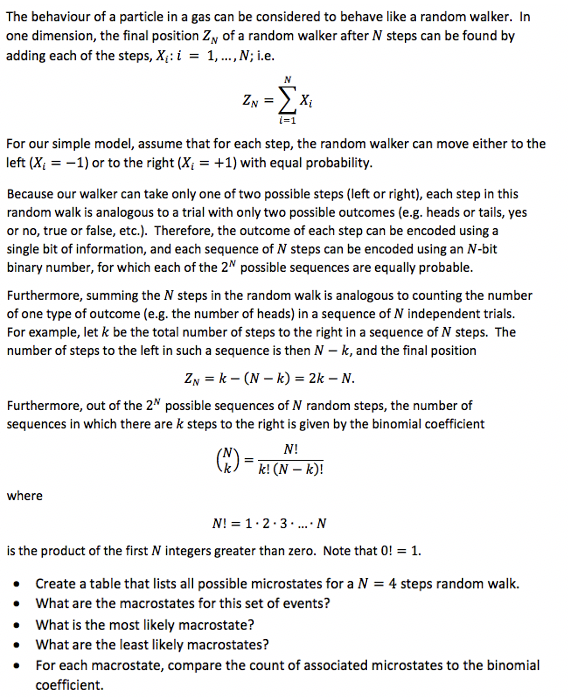
The behaviour of a particle in a gas can be considered to behave like a random walker. In one dimension, the final position 2y of a random walker after N steps can be found by adding each of the steps, Xx: i = 1, ...,N; i.e. N ZN = Xi i=1 For our simple model, assume that for each step, the random walker can move either to the left (X = -1) or to the right (Xi = +1) with equal probability. Because our walker can take only one of two possible steps (left or right), each step in this random walk is analogous to a trial with only two possible outcomes (e.g. heads or tails, yes or no, true or false, etc.). Therefore, the outcome of each step can be encoded using a single bit of information, and each sequence of N steps can be encoded using an N-bit binary number, for which each of the 2 possible sequences are equally probable. Furthermore, summing the N steps in the random walk is analogous to counting the number of one type of outcome (e.g. the number of heads) in a sequence of N independent trials. For example, let k be the total number of steps to the right in a sequence of N steps. The number of steps to the left in such a sequence is then N -k, and the final position 2x = k -(N - k) = 2k N. Furthermore, out of the 2 possible sequences of N random steps, the number of sequences in which there are k steps to the right is given by the binomial coefficient N! ) k! (N-k)! where N! = 1.2.3..... N is the product of the first N integers greater than zero. Note that 0! = 1. Create a table that lists all possible microstates for a N = 4 steps random walk. What are the macrostates for this set of events? What is the most likely macrostate? What are the least likely macrostates? For each macrostate, compare the count of associated microstates to the binomial coefficient. The behaviour of a particle in a gas can be considered to behave like a random walker. In one dimension, the final position 2y of a random walker after N steps can be found by adding each of the steps, Xx: i = 1, ...,N; i.e. N ZN = Xi i=1 For our simple model, assume that for each step, the random walker can move either to the left (X = -1) or to the right (Xi = +1) with equal probability. Because our walker can take only one of two possible steps (left or right), each step in this random walk is analogous to a trial with only two possible outcomes (e.g. heads or tails, yes or no, true or false, etc.). Therefore, the outcome of each step can be encoded using a single bit of information, and each sequence of N steps can be encoded using an N-bit binary number, for which each of the 2 possible sequences are equally probable. Furthermore, summing the N steps in the random walk is analogous to counting the number of one type of outcome (e.g. the number of heads) in a sequence of N independent trials. For example, let k be the total number of steps to the right in a sequence of N steps. The number of steps to the left in such a sequence is then N -k, and the final position 2x = k -(N - k) = 2k N. Furthermore, out of the 2 possible sequences of N random steps, the number of sequences in which there are k steps to the right is given by the binomial coefficient N! ) k! (N-k)! where N! = 1.2.3..... N is the product of the first N integers greater than zero. Note that 0! = 1. Create a table that lists all possible microstates for a N = 4 steps random walk. What are the macrostates for this set of events? What is the most likely macrostate? What are the least likely macrostates? For each macrostate, compare the count of associated microstates to the binomial coefficient







